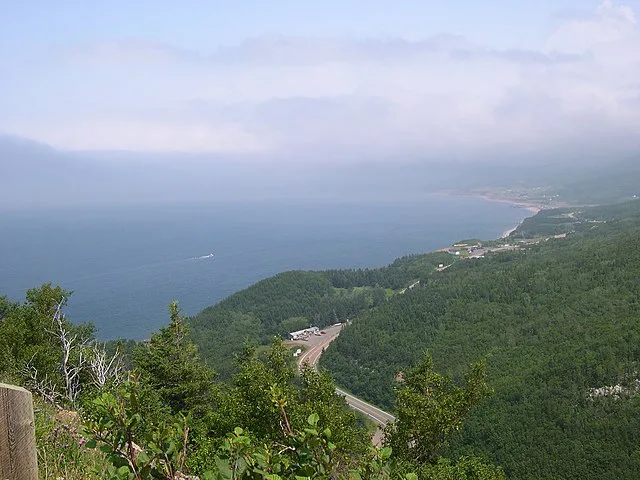You might think that the highest point in all of Nova Scotia, located in the scenic Cape Breton Highlands and in the center of a well-visited National Park, would be a prominent, famous, and popular peak. You would at least expect a well-marked hiking trail to the summit, perhaps crowded on weekends with families and dogs, and with interpretive signs at the trailhead or even at the top. Well, if that is what you thought, then White Hill is almost the exact opposite of that picture.
White Hill- 532 metres . 1,745 feet
| Attribute | Details |
|---|---|
| Altitude | 532 m, 1,745 f |
| Location | 46°42’ 00”N – 60° 36’ 00” |
| NTS Map | Cheticamp River 11 K/10 1:50,000 |
| Calendar | Summer or early Fall |
| Parks | Cape Breton Highlands National Park |
| Fast Facts | CAPITAL: Halifax, Nova Scotia PROVINCIAL FLOWER: Mayflower PROVINCIAL BIRD: Osprey TREE: Red Spruce |
History
The highest point in Nova Scotia is at White Hill Lake in Victoria County, and is part of the Cape Breton Highlands National Park. It stands 530 metres above sea level and is 17 kilometres west of Ingonish.

Author: Dylan Kereluk – wikimedia.org
Routes
It is an extremely remote, lonely, low bump on a marshy, barren, windswept upland about 20 km/13 mi from the nearest road and 10 km/6 mi from any maintained hiking trails.
Recommend the Lake of the Islands trail – you can camp at the lake, and the next day make it to the summit, and maybe even return that afternoon. I climbed White Hill as a 42 km/26 mile one-day hike via the Lake of the Islands.
Go to Cape Breton Highlands National Park. One suggestion is to access the hill from the south via logging roads and by traversing around the eastern shore of Cheticamp Lake – an area out of National Park jurisdiction. Or do White Hill via the Lake of Islands.
The first section to the Lake of Islands campsite is relatively straightforward. The path is a highway amongst trails and 90% of it can be done on mountain bike.
Route to White Hill via Cheticamp Lake to the south. The lake can be accessed by a logging road which starts around Wreck Cove off the Cabot Trail. A general store is supposed to exist at the entrance. The road ends at the south end of Cheticamp Lake. From this point, one will have to bushwhack to the north east end of this huge lake to find a trail which leads to the White Hill junction. The terrain will be extremely wet and at least 2 rivers will have to be crossed. A former Ranger cabin can be found just outside of the park boundary on the trail. This would make a good place to rest for the night.
Exploring White Hill’s Historical and Cultural Significance
White Hill, the highest point in Nova Scotia, holds a rich tapestry of historical and cultural significance that resonates with the land’s Indigenous communities and reflects pivotal events in Nova Scotia’s past.
Indigenous Heritage
For centuries, the ancestral lands surrounding White Hill have been inhabited by Indigenous peoples, including the Mi’kmaq Nation. These Indigenous communities have deep connections to the land, viewing it as sacred and integral to their cultural identity.
The Mi’kmaq people, renowned for their resilience and deep spiritual connection to nature, have passed down stories and traditions that honor the natural wonders of the Cape Breton Highlands, including White Hill. These narratives often emphasize the importance of living in harmony with the land and respecting its resources.
Colonial Encounters
During the era of European colonization, White Hill and its surrounding areas became focal points of exploration, trade, and conflict. European settlers, drawn by the region’s abundant natural resources and strategic location, established settlements and trading posts in the vicinity.
The interactions between Indigenous peoples and European colonizers were marked by both cooperation and tension, as competing interests clashed over land ownership, resource extraction, and cultural differences. White Hill, with its commanding presence in the landscape, likely played a role in shaping these dynamics.
Nova Scotia’s Historical Landscape
As Nova Scotia evolved into a province with its own distinct identity, White Hill remained a prominent landmark, serving as a point of reference for travelers, cartographers, and explorers. Its elevation and visibility made it a valuable navigational aid for sailors along the coast and travelers navigating the rugged terrain.
Throughout Nova Scotia’s history, White Hill has witnessed significant events and transformations, from the arrival of European settlers to the growth of industries like logging, fishing, and tourism. Its enduring presence serves as a reminder of the region’s complex past and the resilience of its people.
Preserving Heritage and Legacy
Today, efforts are underway to preserve White Hill’s natural beauty and cultural heritage for future generations. Organizations, including Parks Canada and local Indigenous groups, work collaboratively to protect and interpret the area’s historical and cultural significance.
By fostering an appreciation for the land’s diverse heritage, we can ensure that White Hill remains a source of inspiration and connection for generations to come.
Trail Challenge and Preparation Guide
Embarking on a hike to conquer White Hill amidst the breathtaking landscapes of Cape Breton Highlands National Park promises an invigorating outdoor adventure. However, to ensure a safe and fulfilling journey, it’s crucial to understand the trail’s challenges and equip yourself adequately.
Trail Difficulty Insights
The path leading to White Hill presents a moderate to challenging trek, catering to hikers with a penchant for wilderness exploration. While not overly technical, the terrain poses various obstacles, including uneven ground, steep gradients, and potential wet or muddy sections, especially in marshy areas.
Essential Gear Checklist

Preparation is key for a successful hike to White Hill. Here’s a checklist of indispensable items to pack:
- Rugged Footwear: Opt for sturdy hiking boots with excellent ankle support and traction to navigate rocky and uneven terrain confidently.
- Weather-Resistant Attire: Layer up with weather-appropriate clothing and include waterproof gear to combat unpredictable weather conditions prevalent in the highlands.
- Trail-Ready Backpack: Carry a durable backpack to stash essentials like water, snacks, extra clothing, navigation aids, and a first aid kit.
- Navigation Aids: Arm yourself with reliable maps, a compass, or GPS device to navigate the trail efficiently, particularly in areas with sparse signage or visibility challenges.
- Emergency Essentials: Pack a comprehensive first aid kit stocked with essentials like bandages, antiseptic wipes, pain relievers, and any necessary medications.
- Hydration and Sustenance: Stay hydrated by carrying an ample water supply and fuel your adventure with energizing snacks like trail mix, granola bars, or fresh fruits.
- Sun Protection Gear: Shield yourself from harmful UV rays with sunscreen, sunglasses, and a wide-brimmed hat, especially in exposed areas devoid of shade.
- Insect Defense: Ward off pesky bugs like mosquitoes and ticks with insect repellent to ensure a comfortable hike free from unwelcome bites.
Weather Awareness
Weather fluctuations can significantly impact hiking conditions on White Hill. Prioritize checking the forecast before setting out and remain prepared for sudden changes in weather patterns throughout your journey. While summer and early fall typically offer favorable hiking conditions, be vigilant against potential fog, rain, wind, and temperature variations that can catch you off guard in the highlands.
Tips for a Secure Journey
Here are some additional pointers to enhance safety and enjoyment during your hike:
- Thorough Planning: Conduct comprehensive research on the trail route, familiarize yourself with the terrain, and meticulously plan your hike, considering factors like distance, elevation gain, and estimated duration.
- Communication Protocol: Prioritize informing a trusted individual about your hiking itinerary, including your chosen route, anticipated return time, and emergency contact details.
- Trail Adherence: Stay on designated paths to minimize environmental impact and mitigate the risk of getting lost or injured in rugged terrain.
- Wildlife Respect: Exercise caution around wildlife, maintaining a safe distance to observe without interfering or endangering yourself or the animals.
- Leave No Trace: Practice responsible outdoor ethics by packing out all waste, respecting wildlife and vegetation, and adhering to Leave No Trace principles to preserve the pristine beauty of the area for future generations.
By embracing these recommendations and adequately preparing for your White Hill excursion, you’ll unlock the full splendor of the Cape Breton Highlands National Park while ensuring a memorable and safe hiking experience.
Conclusion
Despite its status as the highest point in Nova Scotia, White Hill is a remote and lesser-known destination, offering solitude amidst its marshy, windswept landscape. White Hill’s history intertwines with Indigenous heritage and colonial encounters, reflecting pivotal events in Nova Scotia’s past and serving as a navigational landmark throughout history. Efforts are underway to preserve White Hill’s natural beauty and cultural significance, with organizations collaborating to protect its Indigenous heritage and interpret its historical legacy. Embarking on a hike to White Hill requires thorough preparation, including understanding the trail’s challenges, packing essential gear, and staying vigilant against weather fluctuations and wildlife encounters. Practicing responsible hiking ethics, such as staying on designated trails, respecting wildlife, and leaving no trace, ensures the preservation of White Hill’s pristine environment for future generations.
FAQs
What is the best time of year to hike White Hill?
The best time to hike White Hill is during the summer or early fall when weather conditions are generally favorable. However, hikers should be prepared for potential weather changes and dress accordingly.
How long does it take to hike White Hill?
The duration of the hike to White Hill can vary depending on the chosen route, hiker’s pace, and weather conditions. Some hikers may complete the hike in a single day, while others may opt for a multi-day excursion, especially if camping overnight.
Are there any facilities or amenities available at White Hill?
Due to its remote location, White Hill does not have any facilities or amenities such as restrooms, water sources, or food concessions. Hikers should come prepared with all necessary supplies, including water, food, and first aid kits.